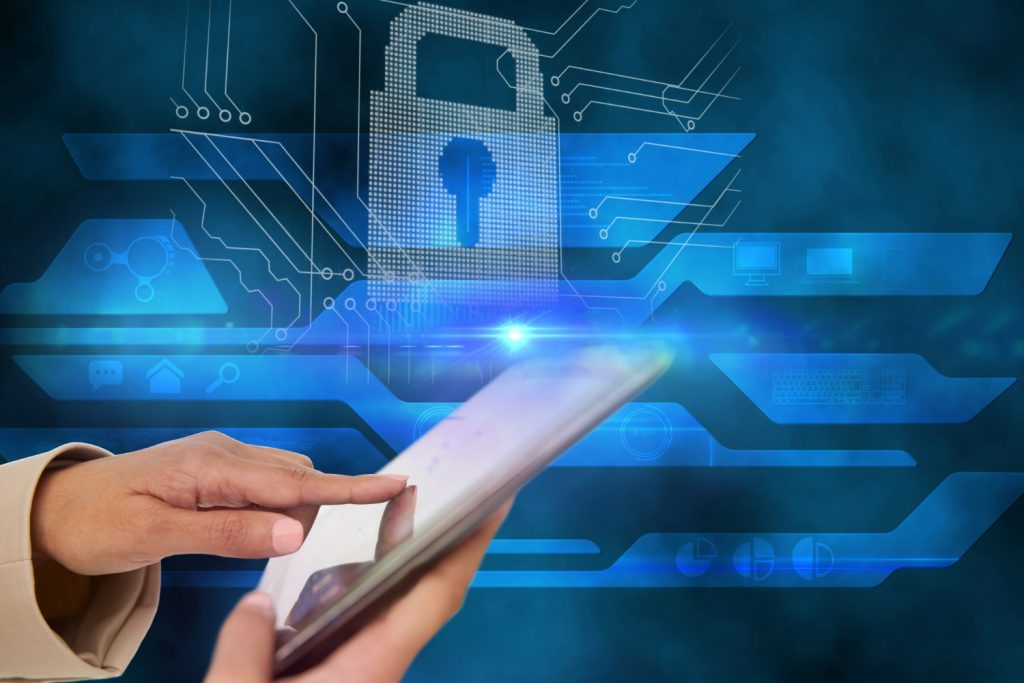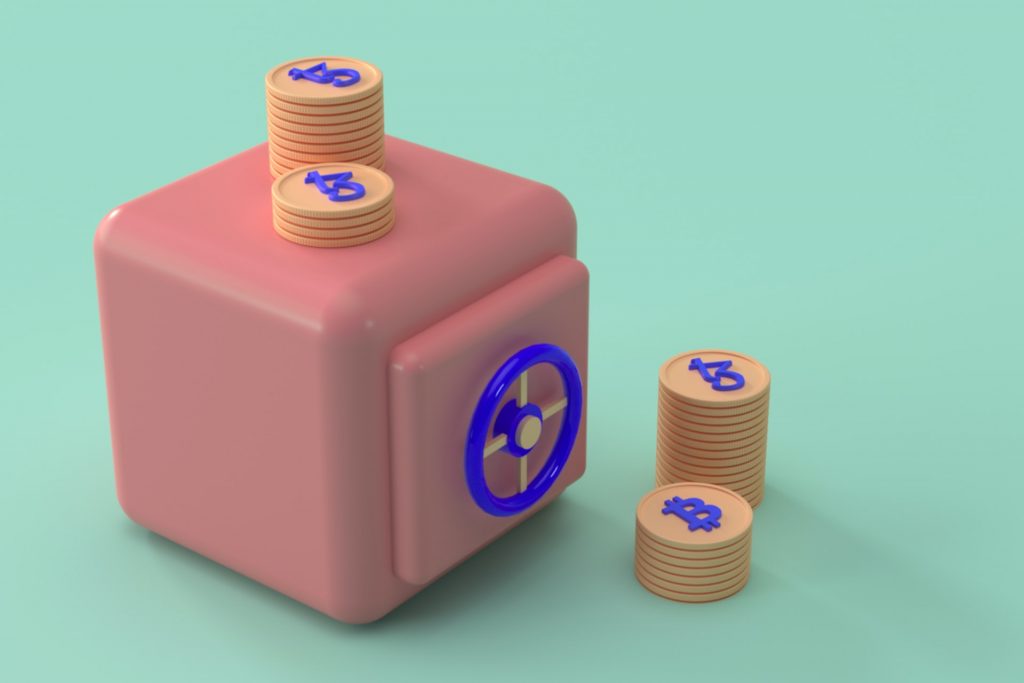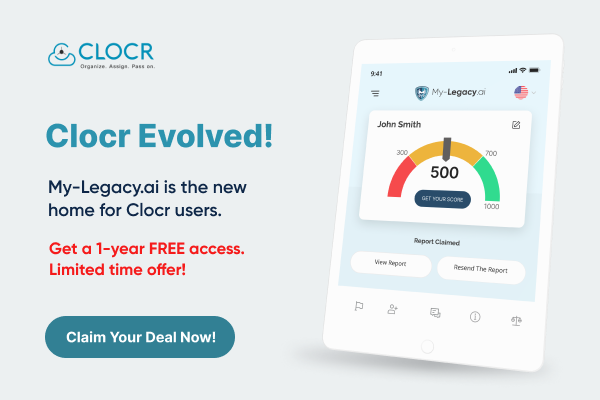People are becoming aware of the need to have a Digital Estate Plan for their Digital Assets. There is no doubt that a part of our daily life includes using a Digital Property such as smartphones, computers, laptops, social media accounts, emails, etc. Collectively, these are known as Digital Assets.
Understanding Digital Assets and their importance plays a major role in planning your Digital Estate and leaving behind a Digital Legacy.
Clocr’s Comprehensive Guide to Understanding Digital Assets
- What are Digital Assets?
- Types of Digital Assets
- Why are Digital Assets important?
- Is transferring Digital Assets necessary when we can share passwords with our beneficiaries?
- How to make Digital Assets more accessible?
- How to identify and organize your Digital Assets?
- Estate Plan for Digital Assets
- Digital Life after Death: How to plan your Digital Assets for your Digital Afterlife?
- How to protect your Digital Assets?
- Legacy Policies
- Commonly asked Digital Assets questions
What are Digital Assets?
A Digital Asset is anything that exists digitally and comes with a right to use. Any digital data that doesn’t come under the rights do not form a part of Digital Assets.
Digital Assets include:
- Electronic devices used to access digital accounts; computers, laptops, smartphones, eBook readers and tablets.
- Social media accounts
- Gaming accounts
- Third-party payment and bank accounts
- Online shopping accounts
- Subscription accounts like Amazon, Netflix, Spotify and online magazines.
- Crypto wallets
- Email accounts
- Cloud storage services
Examples of Digital Assets
- Online documents, tutorials, websites and eBooks.
- Software in the form of code and deployable services
- Data in the form of databases and unstructured formats
- Designs in architectural or visual formats
- Patents and Trade secrets
- Digital Art and Music
- Entertainment and Media
- Web-addresses and domain names
- Digital Currency
Common formats of Digital Assets
- PDFs
- Video
- Presentations
- Audio Files
- Images
- Spreadsheets
- Graphics
- Design Files
Types of Digital Assets
Digital Assets with no monetary value
- Information stored in electronic format on cloud or other online platforms
- Online accounts such as emails, social media, online shopping, gaming profiles, photo and video sharing sites, etc.
- Domain names for personal use – personal blogs for example.
- Intellectual property created or owned by you
Digital Assets with monetary value
- Computer software
- Websites, eBooks or blogs that generate revenue
- Digital art work, photos, videos, music
- Third-party payment sites like PayPal
- Domain names
Digital Assets of an Organization
- Digital property owned by a business organization
- Banking accounts and third-party payment sites registered in the company’s name.
- Online storage services for storing and handling the company’s resources
- Mailing lists, eBooks and other information that generates revenue
- Client information
Why are Digital Assets Important?

In the past few years, we have seen a rise in identity thefts and frauds. Hackers target online accounts of the living and dead alike. If a person does not make arrangements to handle online accounts after their demise and their online accounts become the latest target of a hacker, there is nothing the next-of-kin could do to secure their deceased loved one’s identity or privacy.
Hence, it is always advisable to organize your Digital Assets and create a Digital Estate Plan so that your online accounts remain safe, even after your death.
Reasons to protect your Digital Assets
- Protection from cybercrime.
- Prevent leak of personal information.
- Prevent leak of financial information
- Avoid third-party data breach
How Identity Thefts affect your Online Accounts
With the rise in online users comes a rise in frauds and identity thefts. Hackers target online accounts of the living and the dead equally. Accounts of deceased users are easy targets for identity theft as no one is handling these accounts. If such accounts are hacked, the family information of the deceased might be in the wrong hands.
Is transferring Digital Assets necessary when we can share passwords with our beneficiaries?
If you make a list of usernames and passwords of all the online accounts and include it in your Digital Estate Planning document, you are only giving your beneficiaries a way to access your Digital Assets. You are not transferring it to them via legal means.
Think what would happen if your beneficiary continues to operate your bank account without reporting your death to the bank. In this case, your beneficiary is violating the privacy laws and might not have authorization to make financial transactions.
With the help of a Digital Estate Plan, the beneficiary can claim the account ownership right away.
How to make Digital Assets more accessible?
Are you struggling to keep track of your online accounts? Perhaps you have decided to create a Digital Estate Plan and are finding it difficult to identify and organize all your Digital Assets. This is where a Digital Asset Management system comes in handy.
List your Digital Assets in the order of:
- Usernames
- Passwords (we recommend to use a password manager)
- Permissions and instructions – if the asset is going to be a part of your Digital Estate Plan
How to Identify and Organize your Digital Assets?
Make a list of all the accounts you have ever created – this includes emails, signups to various sites, social media accounts, payment and subscription accounts, gaming profiles and crypto wallets. It is believed that, on an average, a human being in modern times owns over 100 online accounts.
List all your Digital Assets – along with their usernames, passwords and security questions. Include the details of this list in your Digital Estate Plan and name a Digital to handle these accounts.
Steps involved in Identifying and Organizing your Digital Assets
- Digital Assets inventory
- Use different folders for different profiles
- Label your assets with metadata
- Take backup and a backup of a backup
- Control access of Digital Assets
Estate Plan for Digital Assets
Digital Estate Planning is the process of organizing your Digital Assets and making arrangements for what should happen to them after your death.
Do you want your family members to download your important documents and photos from your cloud storage drive?
Should they download all photos and close your social media profiles? Or, should they memorialize them? What about subscription accounts?
These are the decisions that go into your Digital Estate Planning document.
Digital Life after death: How to plan your Digital Assets for your Digital Afterlife?
How to include Digital Assets in your Digital Estate Plan?

You are now familiar with what a Digital Estate Plan is and how to create one. The first step of creating an Estate Plan for Digital Assets – also known as Digital Estate Planning – is to make an inventory of your Digital Assets.
- Make an exhaustive list of all your Digital Assets. Identify usernames and passwords associated with each accounts. Or, use a Password Manager to store usernames and passwords.
- Leave instructions on what should happen to these accounts after your death.
How to protect your Digital Assets
Personal
- Use unique passwords for every account
- Enable two-factor authentication
- Use a password manager tool and turn off ‘save password’ feature
- Clear browser cookies, history and cache
- Create a Digital Estate Plan
Business
- Use a Digital Asset Management Tool
- Limit access to important resources
- Establish ownership and value via patents, trademarks and copyrights.
- Plan for the future: What should happen to your company’s Digital Assets when you pass away? Make arrangements for who’s to receive your company’s Digital Property after your passing.
- Protect servers and online resources from hackers
- Invest in cyber insurance
- Back-up data regularly
Legacy Policies
Legacy policies for payment and subscription accounts
Before you include your Digital Assets in your Digital Estate Plan, it is recommended to have a look at each organization’s legacy policy. Since payment accounts like online banking and transfer/receive funds accounts (PayPal and the likes) hold monetary value, you need to take a look at their legacy policies and see if withdrawals are permitted to next-of-kin after your demise.
Legacy policies for email accounts
When we make a list of Digital Assets, we have to take into consideration all the important emails we have received till date. Some emails might contain attachments like bank statements, certificates of online courses, etc. and have to be included in our Digital Estate Plans. You can instruct your Digital Executor to download important emails and attachments and store them securely. But before you do so, take a look at the service provider’s legacy policy.
Commonly asked Digital Assets Questions
Who owns my child’s Digital Assets?
Most minors do not own any significant properties and if they do, the default rule of intestacy law suggests their property will be inherited by their parents. But with the increase in the usage of the internet, a minor might own a significant amount of Digital Property.
Under the current law, minors have no right to decide what happens to their Digital Assets after death. Currently, the law has begun to address an adult’s succession rights to Digital Assets and hopefully in a couple of years, the same might be extended to minors too.
What happens to my Digital Assets if I pass away?
Your Digital Assets will be handled by your Executor if you have appointed an Executor in your Will or Estate Plan.
If you haven’t made any arrangements for handling your Digital Assets, your family members might have to fight long legal battles with service providers to gain access. Hence, it is always recommended to create a Digital Estate Plan for your Digital Assets.
Is my online banking account a Digital Asset?
A Digital Asset is anything that exists online. If you use online banking facilities then yes, it is considered a Digital Asset. If you use third-party payment applications, they too are considered as Digital Assets.
Is Cryptocurrency a digital asset?
In short, yes.
Cryptocurrencies work on the principle of Public and Private keys. While public keys are sharable, private keys are specific to customers and should not be shared with anyone. Also, the device used to buy cryptocurrencies are important. Unless you make arrangements for your next-of-kin to access the device used to buy cryptocurrencies and private keys, your crypto wallet becomes inaccessible after your death.
Do I need an Estate Plan for my Digital Assets?
It is always recommended to create an Estate Plan for your Digital Assets or a Digital Estate Plan. Including Digital Assets in your Estate Planning document or creating a Digital Estate Plan gives you and your family members a way to handle your Digital Assets after your death.




